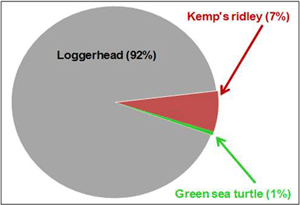Research

A pie chart showing the relative composition of sea turtle species captured in the regional trawl survey between 2000 and 2011. Loggerhead sea turtles remain the most commonly collected species, but annual captures of Kemp’s ridley sea turtles have been increasing steadily since 2010.
The primary research objectives of this program are to monitor trends in the composition, relative abundance, distribution, demographic, and health parameters of sea turtles captured in coastal waters in the South Eastern USA. Between 2000 and 2011, more than 2,000 sea turtles were captured by this program, 92% of which were loggerhead sea turtles (adults and juveniles), 6% of which were Kemp’s ridley sea turtles (adults and juveniles), and 1% of which were green sea turtles (small juveniles only).
The core mission of the program relies upon the use of trawling to capture sea turtles followed by measurements and collection of blood and other biological samples, but additional data collection techniques have also been added as the needs for additional information have arisen. Most notably was the deployment of satellite transmitters to a sub-set of loggerhead sea turtles captured between 2004 and 2007 in order to better understand their seasonal distribution patterns. In 2006 and 2007, a suite of diagnostic techniques for assessing the reproductive activity levels of adult male loggerhead sea turtles were evaluated, which validated the use of ultrasound as a field technique for assessing reproductive development among maturing loggerhead sea turtles. Modified sampling designs have also been evaluated as a means for increasing the statistical strength of the capture rates reported in this unique data set.

The second (by less than a quarter inch) smallest of more than 150 juvenile Kemp’s ridley sea turtle captured by the in-water trawl survey since 2000.
Although there are still additional analytical needs that require attention, the vitality of this trawl survey for monitoring sea turtle populations in the NW Atlantic Ocean is now widely appreciated. We anticipate that this in-water sea turtle research program will be of even greater value in the incipient decade than in the previous decade due to the ability to monitor recruitment trends for sea turtles hatched since 2000. Specifically, we’ll be monitoring potential increases in small Kemp’s ridley sea turtles as a result of a sustained nesting resurgence period since 20006, but which could coincide with a decline in capture rates for small loggerhead sea turtles as a result of an abrupt decrease in nesting during most of the same period7.
6 Heppell, S.S., D.T. Crouse, L.B. Crowder, S.P. Epperly, W. Gabriel, T. Henwood, R. Marquez, and N.B. Thompson. 2005. A population model to estimate recovery time, population size, and management impacts on Kemp‘s ridley sea turtles. Chelonian Conservation and Biology 4(4):767-773.
7 Witherington, B., P. Kubilis, B. Brost, and A. Meylan. 2009. Decreasing annual nest counts in a globally important loggerhead sea turtle population. Ecological Applications 19(1):30–54.
